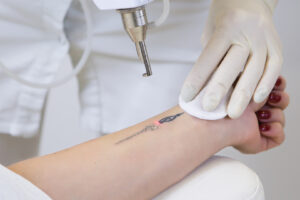
With ever changing fashion, lifestyle and interests, it is a common occurrence for people to change their mind, deciding they no longer want a tattoo. The reasons for this could simply be that you have become bored with your tattoo, or perhaps regret getting a tattoo completely. The decision to have a particular design, or the message that their design implies, may no long be appropriate due to lifestyle changes as we get older.
An unwanted tattoo can be more than just unsightly, they can have an impact on a person’s confidence, as well as their relationships.
For some people, their tattoos may still be attractive but they are located in the wrong place – meaning tattoo cover-ups do not solve the problem. Regardless of the reason for the dislike of your tattoo, if you are unhappy you may want to consider permanent laser tattoo removal.
While a huge percentage of us are aware that laser tattoo removal is readily available, many would struggle to provide a detailed answer if asked, what is laser tattoo removal? Our laser specialist prepared a full guide to this sought-after treatment, filled with everything you need to know if you are considering laser tattoo removal.
What Is Laser Tattoo Removal:
As a tattoo is designed to last a lifetime, the number of sessions you will require depends on how deep the ink is into your skin and the ink used; this varies on the tattooist you opt for along with how heavy-handed they were at the time.
Tattoo ink is formed of colored pigments, which is removed from the skin layer by layer using lasers. The removal of a tattoo must be completed on small sections at a time spread across a number of months. Attempting to treat the tattoo in just one session will overwhelm the skin, which will leave marks on the skin and scarring. Laser tattoo removal done progressively however, will leave no scarring.
Lasers used in tattoo removal usually have six levels of frequency as each color pigment responds to a different frequency of energy. In some cases, if the tattoo includes many different vibrant colors, your laser consultant may need to switch between frequencies to maximize results.
Tattoo removal methods have come a long way in the last 10 years with new Tattoo Removal Lasers making the process easier than ever before. The laser goes to the dermis layer of skin, making contact with ink, breaking the ink down to particles small enough for the lymphatic system to dispose of. The body will then begin absorbing the broken down ink, flushing it out through your lymphatic system.
The Best Candidates
Anyone who has a tattoo they no longer want is the perfect candidate for laser tattoo removal; however, there are a few factors that will contribute towards how effective your results are.
Those who have fairer skin are likely to achieve noticeable results in a shorter time period. This is because darker colors are able to absorb laser energy better, which means that if there is a contrast between the fair skin and tattoo ink, your laser consultant can target the pigmented areas better. Only the tattoo ink will absorb the energy, meaning that no surrounding skin will be damaged and it will take fewer sessions for the tattoo to begin to fade. Candidates with a darker skin tone are still able to book in for laser tattoo removal and ink will still be able to be removed; however, it may take slightly more sessions.
Tattoos that have only been created using black ink will also take fewer sessions to remove. As mentioned previously, different colored ink often requires different frequencies of energy, whereas black ink is able to absorb almost every frequency. This means that black will fade easier and quicker.
Although it is often not considered, your health does have an impact on how effective your results are from laser tattoo removal. All ink broken down during treatments needs to have the ability to pass through the body and be removed effectively, which is only possible if your immune system is in a good working order. If your immune system is low, then you may want to consider waiting a while until you are in better health to begin laser sessions.
Considerations Before The Treatment
There are a few things that you must consider and keep in mind before opting for laser tattoo removal. The first is that although it may sound obvious, when your tattoo is gone, its gone for good, so you must ensure that you are entirely sure that this is the best route for you. Once you have finished your set of sessions and the skin has completely healed, you can re-tattoo over the area. In some cases, clients chose to remove just one section of the tattoo, so they can begin to build a different design.
It is important to have realistic expectations of laser tattoo removal and remember that it can become a lengthy process. You will not be able to remove the full tattoo overnight, so it will take both time and patience to achieve maximum results. Some people are able to fade their tattoo to the level they had hoped in five sessions and for others, it will take ten sessions for the same results. The time it takes varies person to person depending on contributing factors such as tattoo size, color, the part of the body the tattoo is on and how the body recovers.
Last, but not least, laser tattoo removal will come alongside slight discomfort but is most definitely not unbearable pain. If you were able to withstand the pain of getting the tattoo in the first place, then the feeling of tattoo removal will be nothing compared to that sensation. Most clients describe the feeling as if they are being flicked with an elastic band, which you do get used to in a few minutes. Due to the advanced technology now used for laser tattoo removal, there are in-built cooling properties which will make the feeling considerably more manageable. You can also apply a topical numbing cream to the skin before your session if you are particularly worried about the pain. If you have a low pain tolerance, then you may want to discuss a shorter initial session to get you used to the feeling and then build up as time goes on.
Preparing For Tattoo Removal Sessions
It is vital to ensure that your skin is in good condition before beginning laser tattoo removal to lower the risk of possible side effects.
Skin that is sunburn or is damaged due to over-use of sunbeds cannot be treated. Lasers are high-intensity and emit heat energy, which means that skin that is already damaged will begin to blister when treatments begin. As laser tattoo removal sessions will continue over many months, it is important to keep your skin away from sun exposure in the meantime. Many clients opt for booking their sessions over the Winter period when they are less likely to be out in the sun and will not be as eager to maintain their tan. If your laser tattoo removal sessions do run into the warmer months, it is critical to always wear SPF at all times.
Before your sessions, the treatment area must be shaved and free from any moisturizers, serums or perfume. Skin that is clean and free of products will be able to accept the laser better, therefore maximizing your results. To maximize comfort, it is also recommended to wear loose-fitting clothing over the area that is being treated. It means that the skin will not be grazed by tight clothing after the treatment when it is feeling a little sensitive.
A key preparation tip that many clients opting for laser tattoo removal do not consider is the impact pain killers have on their side effects. If you are particularly worried about the discomfort you may feel during sessions. Never take Aspirin or Ibuprofen before a laser treatment because they will both make the skin bruise and bleed more afterwards.
Possible Side Effects
Similarly to any other cosmetic treatment, laser tattoo removal does come alongside possible side effects. Immediately after laser tattoo removal, the skin is likely to be slightly red and raised, which will subside quickly. You can use a cold compress or a pack of frozen peas wrapped up to help the swelling to go down.
The treatment area will also experience a side effect called ‘frosting’. If you have seen laser tattoo removal before, you would have noticed that the ink has what appears to be a white layer over the top after being treated; this is frosting. The reasoning behind frosting is simple and is actually a good thing; it is an indication that the session has been successful. It proves that the reaction between the laser and pigment has begun and the energy had penetrated into the skin. Signs of frosting are likely to appear around half an hour after your treatment.
Treatment Aftercare
For around a week after your session, the skin may remain slightly tender with the possible risk of scabbing. If this is the case, although it may be frustrating, do not itch or pick the scabbing as it is the body’s natural healing process. Removing scabs before they are ready may lead to scarring or an infection. Instead, try applying aloevera gel to keep the skin hydrated and to stop the area from itching as much.
Always keep the skin clean and away from any perfumed products such as soaps or creams until the skin has healed and all redness, swelling and scabbing has gone.
Your laser specialist will give you a tailored set of aftercare instructions to follow after each session.
Book Your Laser Tattoo Removal Consultation Today!
Laser tattoo removal is quickly becoming one of the most popular treatments amongst cosmetic clinics due to its highly effective results. Always ensure that you only book sessions with a reputable and fully trained laser specialist who is operating a licensed business.
For more information please click here.



